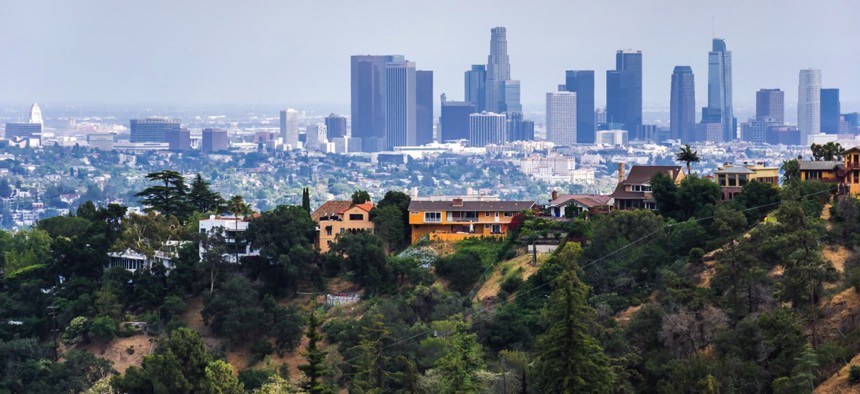Los Angeles Seeks to Build—and Share—an Earthquake Early Warning App

Los Angeles, California

Connecting state and local government leaders
The effort is part of a pledge by Mayor Eric Garcetti, as well as a broader push to bring an earthquake early warning system to the West Coast.
Local officials in Los Angeles are seeking a firm to design an “Earthquake Early Warning Mobile Application for use by City residents.”
The request for proposal , which comes from the Mayor’s Office of Public Safety, lays the groundwork for an app to provide citizens with an early warning when an earthquake is about to hit. And, for those beyond the nation’s second-largest city, the RFP is written to ensure it’s built in a way that other communities can take advantage of it.
The mobile alert platform will be built on the data provided by the U.S. Geological Survey ShakeAlert notification platform . While the platform is still being built out , it consists of a network of sensors that can detect the initial “p-wave” of an earthquake before the arrival of the more destructive “s-wave.” ShakeAlert’s sensors work together to calculate the location and magnitude of the earthquake. In tandem with an application, the sensors could push a location-based alert to those in areas at risk. As the RFP states, “the seconds to minutes of advance warning can allow people and systems to take actions to protect life and property from destructive shaking.”
Making Los Angeles a more resilient city has been a key policy priority for Mayor Eric Garcetti. In his State of the City speech in April, the mayor declared that “by the end of 2018, we will deploy an earthquake early-warning system to every corner of this city—in schools, at businesses, even on your smartphone.” This RFP appears to be a step toward the mayor fulfilling that promise.
Before L.A. residents get to download an earthquake early-warning app, it will be beta tested by some 50,000 city employees. During this time, issues like latency, how to educate the population on usage of the app and what to instruct those with it to do when it goes off will need to be determined.
If the RFP and resulting app is successful, it should provide benefits far beyond the citizens of Los Angeles. The RFP requires that the company that creates the app “agree to publish the Mobile App design on a repository publication open source platform.” This would allow other city, county and state agencies to customize and improve on the app as the ShakeAlert early-warning system matures and grows. ShakeAlert’s boosters hope to expand the network across California, Oregon and Washington state.
Despite the ShakeAlert system being only partially built out, USGS Early Earthquake Warning Coordinator Doug Given told Route Fifty that the agency is confident in the ability of the network to provide data for the city of Los Angeles: “We do have enough sensors in the greater L.A. area to do that—and do it well.”
This makes the city a prime testing ground for public alerts. While there are system evaluations that must occur before public alerts can take place, according to Given, “we anticipate that won’t be a huge issue, and so our goal is to begin some limited public alerting in 2018.”
The ShakeAlert sensors have been tested on a limited basis in California since 2012 and can provide several seconds of forewarning before a severe earthquake. For instance, some 375 miles northwest of Los Angeles, the Bay Area Rapid Transit utilizes ShakeAlert to automatically slow trains before severe shaking arrives . After this initial testing with partners such as local government entities and private industry, USGS believes ShakeAlert is close to ready for a more public debut.
However, effectively alerting the public is far more complex than sharing a warning signal with a select few entities.
“Doing mass alerting with the speeds necessary for earthquake early warning to be effective—that technology doesn’t really exist today,” Given said. Cell carriers can push out emergency alerts, but those warnings are not quick enough to respond to an earthquake. “You may have been in a large meeting when a weather alert or AMBER alert came through, and people’s phones are going off over the course of minutes because there’s a variability in the speed of delivery of those alerts through the cell carriers.”
It doesn’t get much easier when trying the app-based push approach.
“What we’ve been told so far is that if you try to alert hundreds of thousands to millions of people that the alerts will go very, very slow,” Givens explained. “That’s part of the city of Los Angeles work that we’re doing together. They’re going to develop an app and then we’ll be able to test the speed of delivery through push notifications and see if it really does start to keel over and at what point it starts to slow down.”
The RFP requires that the app must take no longer than 5 seconds to “receive, comprehend, and distribute” the alert to 95 percent of its users, displaying the “shaking intensity” at the users’ location.
An early warning system is very possible, though. In fact, earthquake early warning systems already exist in several other countries, including Japan, Mexico, China, Italy and Taiwan.
According to ShakeAlert’s website, “stable funding to complete the system has not yet been secured” and only two-thirds of the “estimated $16.1 million needed annually to maintain and operate the system has been allocated.” Based on the current 2018 House and Senate appropriations bills, Congress intends maintain level funding for the project at $10.2 million, though it was not included in the President’s budget. California’s Office of Emergency Services and the Los Angeles/Long Beach Urban Areas Security Initiative provide additional funding and support.
RELATED on Route Fifty :
Mitch Herckis is Senior Director of Programs at Government Executive’s Route Fifty and is based in Washington, D.C.

NEXT STORY: Governors prep for disruptive technology





